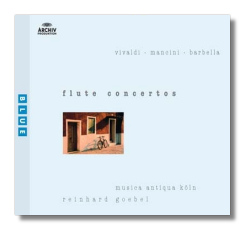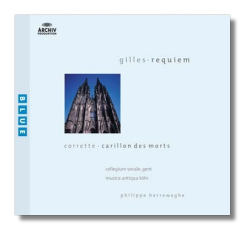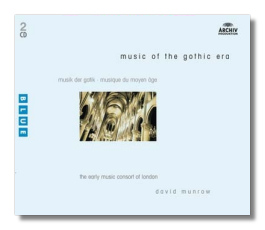
The Internet's Premier Classical Music Source
Related Links
- Vivaldi Reviews
- Latest Reviews
- More Reviews
-
By Composer
-
Collections
DVD & Blu-ray
Books
Concert Reviews
Articles/Interviews
Software
Audio
Search Amazon
Recommended Links
Site News
 CD Review
CD Review
Archiv "Blue" Reissues

- Antonio Vivaldi:
- Concerto da camera in a minor, RV 108 *
- Concerto da camera in D Major, RV 84 **
- Concerto da camera in G Major, RV 102 **
- Concerto da camera in D Major, RV 89 **
- Sonata in D minor "La Follia," RV 63
- Francesco Mancini:
- Sonata in E minor *
- Sonata in D minor *
- Francesco Barbella: Sonata in C Major *
* Gudrun Heyens, recorder
** Wilbert Hazelzet, transverse flute
Musica Antiqua Köln/Reinhard Goebel
Deutsche Grammophon Archiv 471729-2 ADD 77:31


- Jean Gilles: Messe des morts (Requiem)
- Michel Corrette: Carillon des morts
Anne-Marie Rodde, soprano
Jean Nirouët, alto
Martyn Hill, tenor
Ulrich Studer, Peter Kooy, basses
Collegium Vocale Gent/Philippe Herreweghe
Musica Antiqua Köln/Reinhard Goebel
Deutsche Grammophon Archiv 471722-2 ADD 48:47


Music of the Gothic Era
- Léonin:
- Viderunt omnes
- Alleluya Pascha nostrum immolatus est
- Gaude Maria
- Locus iste a Deo factus est
- Pérotin:
- Viderunt omnes
- Sederunt principes
- Adam de la Halle:
- De ma dame vient
- J'os bien a m'amie parler
- Philippe De Vitry:
- Impudenter circumivi
- Cum statua
- O Philippe/O bone dux indolis optime
- Guillaume de Machaut:
- Hoquetus David
- Christe qui lux es/Veni creator/Tribulatio proxima
- Lasse! comment oublieray/Se j'aim mon loyal/Pour quoy me bat mes maris?
- Qui es promesses de Fortune/Ha, Fortune! trop suis mis loing/Et non est qui adjuvet
- Philippus Royllart: Rex Karole, Johannis genite
- Bernard de Cluny: Pantheon abluitur
- Egidius de Pusiex: Portio nature/Ida capillorum/Ante thronum Trinitatis
- Henri Gilles de Pusieux: Rachel plorat filios
- Petrus de Cruce: Aucun ont trouvé
- Anonymous: Various Works
James Bowman, Charles Brett, David James, countertenors
Roger Covey-Crump, Paul Elliott, Martyn Hill, John Nixon, John Potter, tenors
Geoffrey Shaw, bass
Early Music Consort of London/David Munrow
Deutsche Grammophon Archiv 471731-2 ADD 2CDs: 67:16, 72:04
Deutsche Grammophon's Archiv line, formed in the 1950s, was intended to preserve and disseminate early music from up to and including the Classical period. Older collectors often got their first tastes of Bach cantatas, Renaissance polyphony, and other rare delights through Archiv LPs. Early on, the silver-labeled discs came in distinctive mustard-yellow jackets; later, the jackets were given a more distinguished pale-grey hue. (Stylistically unified packaging always has been important to Deutsche Grammophon, although the focus has blurred a little in the CD age.)
When CDs came around, DG reissued many of its main-label offerings in the new medium, and it continues to do so. Archiv reissues lagged behind and still do, probably because the market for early music is smaller. I am guessing that more than half of the main label's stereo releases have been reissued on CD by now, but quite a bit less than half of Archiv's releases have made it into the CD age, unless they were digitally recorded to begin with.
These three CDs are from a new Archiv reissue series called simply "Blue." The only thing blue about them is the shade of the jewel boxes and the CD label. (My sentimental preference would have been to stick to the old label or cover colors and designs, but oh well.) Some of these initial reissues have been on CD before, but I think others are new to the medium. I encourage Deutsche Grammophon to keep sailing on this tack, as there's a lot of great Archiv material waiting to be reissued; these first reissues only scratch the surface. (Keep an eye out for a budget box reissue of the classic Archiv Zelenka recordings in the near future.)
The Musica Antiqua Köln CD goes under the title "Flute concertos" – a misleading description, as the recorder plays a starring role here, and there are no concertos in the usual sense of the word. A "concerto da camera" is a chamber concerto in which the soloist is accompanied by, and dialogues with, a small ensemble, not a full orchestra. For example, in RV 108, the recorder is joined by flute, two violins, and the basso continuo (here, consisting of cello, violone, and harpsichord).
The five Vivaldi selections are like old friends to me, as I acquired the original LP upon its release in the early 1980s. Back then, MAK's performances were almost revolutionary, and they still have a lot to offer both the scholar and the music-lover. Goebel pushes the music hard, but the results only occasionally sound driven, and they often are tremendously exciting. To me, the highlight of the LP was the "Follia" (or "Folia") Variations, a showpiece for two violins, played by Goebel and Hajo Bäss. That's not to say that Heyens and Hazelzet aren't impressive; they are, and the formers warm tone does much to keep the music direct and communicative, even at its most decorative.
Throughout this disc, one is treated to samples of brilliant musicianship wedded to lively scholarship. While these works aren't as well known as "The Four Seasons," they are on the same high level, and no one will be bored or, after hearing them, make that silly statement that Vivaldi wrote the same concerto 500 times. Mancini and Barbella were Vivaldi's contemporaries, although these sonatas apparently predate Vivaldi's concerti da camera. The three sonatas seem a little old-fashioned, especially coming after the Vivaldi extravaganza, but Heyens and MAK make strong cases for them. The late analog engineering doesn't require any apologies. Especially for the Vivaldi, this is a CD well worth exploring.
French composers of the1600s wrote relatively few complete settings of the Requiem mass because the fashion of the time required more showy displays of mourning than could easily be accommodated by the genre. Jean Gilles, who lived between 1668 and 1705, wrote this mass at the end of his life as the exception that proved the rule. It was commissioned, supposedly, by the city fathers of Toulouse, who then reneged on their contract when Gilles delivered a mass whose luxuriousness exceeded their expectations. The angry composer vowed the work would not be played until his death, and that is exactly what happened not long after. The mass then was recognized as a masterpiece by a few musical cognoscenti, and it accompanied both Jean-Philippe Rameau and Louis XV to their graves later in the 1700s. When it was published in 1764 by composer Michel Corrette, his own instrumental Carillon des morts was added, and it has become traditional to perform the two works back to back. It should be noted, however, that Corrette's version of Gilles's Requiem preserves the publisher's own inflated orchestration. Herreweghe has trimmed Corrette's fat away to leave a lean and lithe work that must be quite close to what Gilles would have heard, had he lived to hear his Requiem! (Shades of Mozart, almost a hundred years later.)
Most Requiems are, forgive the phrase, grave affairs. Gilles's Requiem, however, dances along much of the time. It is quite a cheerful work, more appropriate for listeners (or the dead!) who frequented theaters more often than churches. There are many solos for the vocalists – again, more operatic than solemn and devout – and if the chorus lends a more serious tone to the proceedings with excellent 17th-century counterpoint, Gilles's Requiem brings us to the edge of the grave with a smile on our lips and a spring in our step. The Carillon des morts, as its name suggests, is imitative of bells – not just those that would have been played at a funeral, though. Corrette also seems unwilling to don the black crepe.
This 1981 recording, taped in Ghent, paired Herreweghe (who has become very well-known in the meantime) with MAK and Goebel – a combination never seen before and never repeated since, as far as I know. MAK is less suited to the French style, but they still play with spirit and authenticity. Herreweghe's reputation as a fine choral director is maintained here, and the soloists are pure-toned. A touch more theatricality would not have been amiss. This CD is a direct transfer from the original LP – it is a little short for a reissue!
David Munrow's collection of Music of the Gothic Era, recorded back in 1975, was hailed upon its release not only for its historical value, but also for the imagination that Munrow and his colleagues showed in realizing manuscripts that often are as open-ended as they are ancient. Munrow was a scholar, but he was anything but a dusty person, and his death not much later at the age of thirty-four was a major disaster for the Early Music field. Many still mourn him today.
The original set of three LPs has been neatly reduced to two CDs. Part of the first disc is devoted to music from the so-called "Notre Dame" period (about 1160-1250), which is represented by two- and four-voiced organa by Léonin and Pérotin. The latter's "Viderunt omnes" and "Sederunt principes" is music that has been recorded more and more since Munrow did so, and from almost as many perspectives, but Munrow's realizations remain fresh and viable, probably because he eschewed the excesses and gimmicks later performers have imposed. Next, there is a sequence of anonymous motets from circa 1250 to circa 1320, and what really makes this portion of the program attractive is Munrow's concern for variety – different combinations of singers and instruments (the shawm, the tabor, the mandora, the psaltery, the rebec, and so on) would have diverted even the most inattentive nobleman of that era. Motets by Adam de la Halle and Petrus de Cruce are included as well. Moving into the age of "Ars Nova" (circa 1320 until circa 1400), there are motets by Philippe de Vitry, Bernard de Cluny, Henri Gilles de Pusiex, Guillaume de Machaut, Philippe Royllart, and, once again, Monsieur Anonymous. Again, Munrow relied upon a diverse (but, in contrast to most early efforts to bring this music forward, not inflated) cast of singers and instrumentalists to demonstrate the music's continued viability.
Unfortunately, this reissue lacks the copious documentation that was included with the original LPs. Texts and translations are included, however, as is the curious glossary of old French… which is useful only if you are familiar with modern French! The engineering retains its original purity and depth.
Copyright © 2002, Raymond Tuttle




















